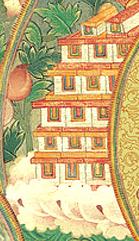Dharma: Difference between revisions
Jump to navigation
Jump to search
mNo edit summary |
|||
| Line 1: | Line 1: | ||
[[Image:Dharma.JPG|frame|Dharma texts from the [[Longchen Nyingtik]] [[Field of merit]]]] | [[Image:Dharma.JPG|frame|Dharma texts from the [[Longchen Nyingtik]] [[Field of merit]]]] | ||
'''Dharma''' (Skt. | '''Dharma''' (Skt.; Tib. ''chö''; [[Wyl.]] ''chos'') — the word used to refer to the teachings of the [[Buddha]] (Skt. ''Buddhadharma''). It has many shades of meaning, including ‘the spiritual path’, or ‘spirituality’ in general. It also refers to phenomena, meaning things and events. ''See also'' [[ten meanings of Dharma]]. | ||
==Subdivisions== | ==Subdivisions== | ||
===Dharma of transmission=== | ===[[Dharma of transmission]]=== | ||
{{:Dharma of transmission}} | {{:Dharma of transmission}} | ||
===Dharma of realization=== | ===[[Dharma of realization]]=== | ||
{{:Dharma of realization}} | {{:Dharma of realization}} | ||
==Eight Qualities of the Dharma== | ==Eight Qualities of the Dharma== | ||
Revision as of 19:08, 18 March 2010

Dharma (Skt.; Tib. chö; Wyl. chos) — the word used to refer to the teachings of the Buddha (Skt. Buddhadharma). It has many shades of meaning, including ‘the spiritual path’, or ‘spirituality’ in general. It also refers to phenomena, meaning things and events. See also ten meanings of Dharma.
Subdivisions
Dharma of transmission
The Dharma of transmission (Skt. āgama dharma; Tib. ལུང་གི་ཆོས་, Wyl. lung gi chos) consists of the three collections (pitaka): Vinaya, Sutra and Abhidharma.
Dharma of realization
The Dharma of realization (Tib. རྟོགས་པའི་ཆོས་, tokpé chö, Wyl. rtogs pa'i chos) is the threefold higher training:
- The training in higher discipline, which is the subject matter of the vinaya collection.
- The training in higher meditation, which is the subject matter of the sutra collection.
- The training in higher wisdom, which is the subject matter of the abhidharma collection.
Eight Qualities of the Dharma
According to Maitreya's Uttaratantra Shastra, the Dharma has eight qualities of cessation and the path:
Path:
- 1) purity, since free from emotional obscurations
- 2) clarity, since free from cognitive obscurations
- 3) remedy, since it overcomes both obscurations
Cessation:
- 4) inconceivable, since beyond concepts
- 5) utterly peaceful, since it is free from karma and disturbing emotions
- 6) unfathomable, since individually cognized
And
- 7) cessation; and
- 8) the path.
Further Reading
- Khenpo Ngawang Palzang, A Guide to the Words of My Perfect Teacher, Shambhala, 2004, pages 107-108.
- Thinley Norbu, The Small Golden Key (Shambhala Publications, 1999), ‘10. The Dharma of Precept and Dharma of Realization.'